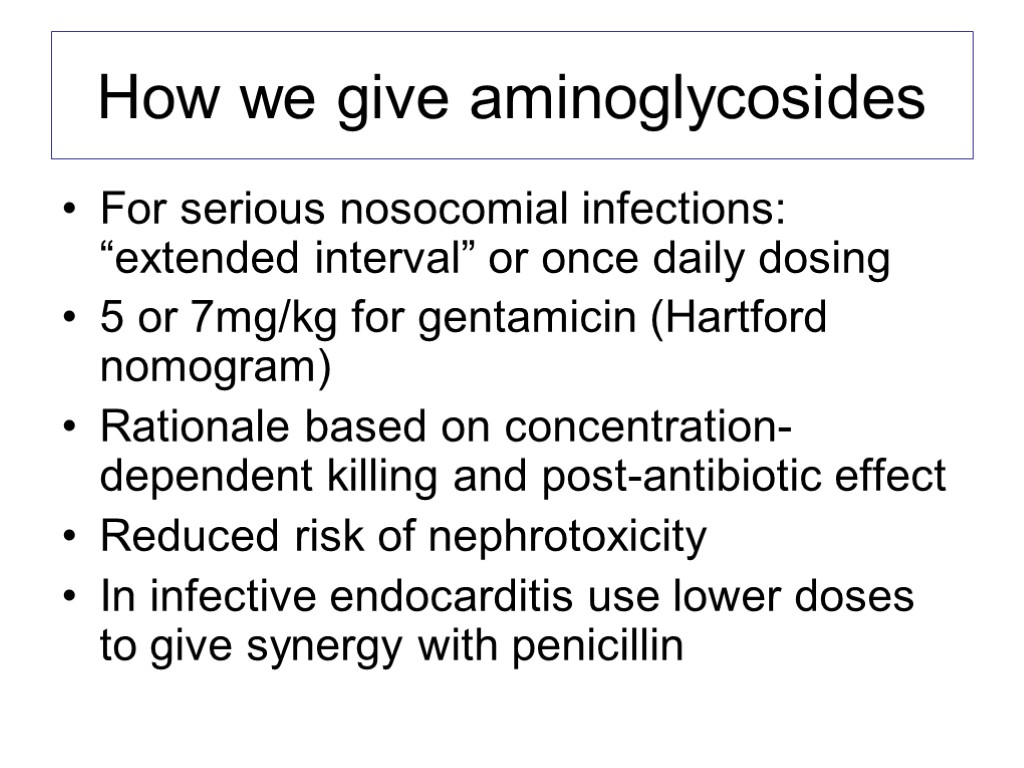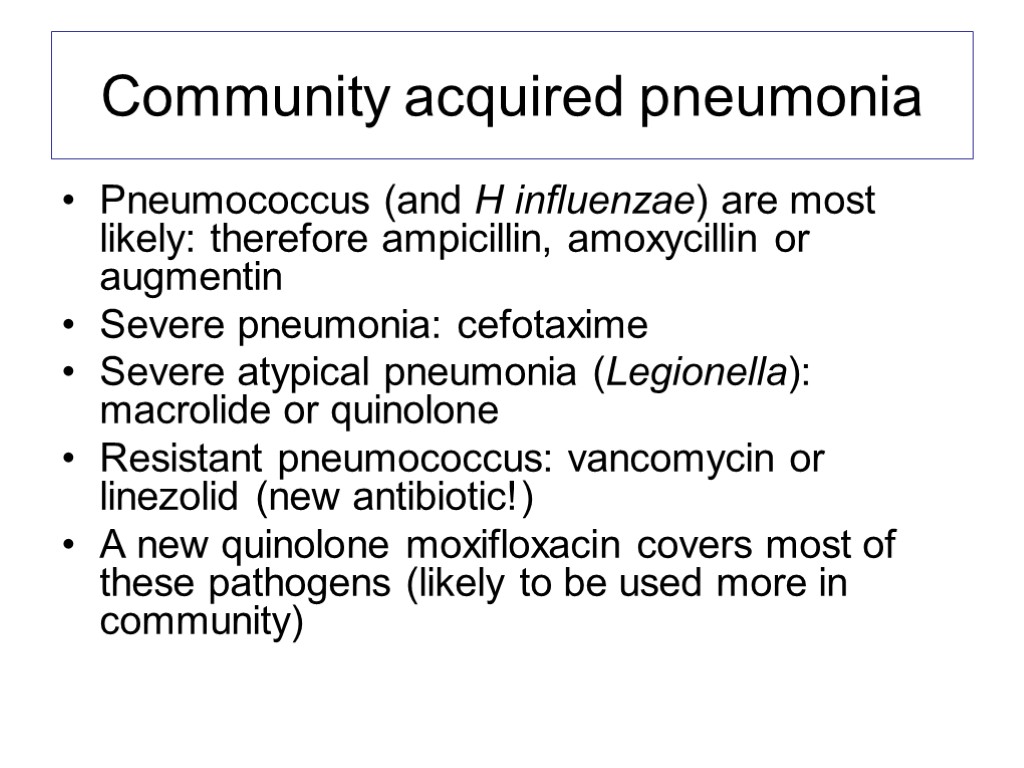ANTIBIOTICSSOME GENERAL PRINCIPLES Antibiotics can be naturally produced,


ANTIBIOTICS

SOME GENERAL PRINCIPLES Antibiotics can be naturally produced, semi-synthetic, or synthetic substances Designed to have as much selective toxicity on the bacteria as possible This is more likely to be achieved compared to antimicrobials acting against eukaryotic cells (fungi, protozoa)

EXAMPLES OF SELECTIVE ACTION Penicillin on bacterial cell wall (organisms without cell wall won’t be inhibited eg Mycoplasma pneumoniae) Sulphonamides prevent bacteria synthesising folic acid whereas humans can use preformed folate Generally drugs acting on cell membranes or protein synthesis are more toxic to humans

ANTIBIOTICS ACTING ON CELL WALL OF BACTERIA Beta lactams: Penicillins, cephalosporins, carbapenems, monobactam Glycopeptides: Vancomycin, teicoplanin

THE IDEAL ANTIBIOTIC?:PENICILLIN Narrow spectrum Bactericidal Very selective mode of action Low serum protein binding Widely distributed in body esp. CNS Excreted by the kidneys

THE DEVELOPMENT OF THE BETA LACTAMS Benzylenicillin and early cephalosporins mainly active against gram positive bacteria (strep and staph) Then “broad spectrum” penicillins appeared: ampicillin, ureidopenicillins and cephalosporins: cefuroxime, cefotaxime Carbapenems and latest generation of cephalosporins, eg ceftazidime more active against gram negatives

BENZYLPENICILLIN: MAIN INDICATIONS Strep pyogenes sepsis (from sore throat to fasciitis) Pneumococcal pneumonia, meningitis Meningococcal meningitis, sepsis Infective endocarditis (strep) Strep group B sepsis Diphtheria Syphilis, leptospirosis

Broader spectrum penicillins Ampicillin, amoxycillin cover most organisms hit by penicillin but also Esch coli, some Proteus (cause UTI’s) Augmentin stable to TEM1 beta lactamase because of the clavulanic acid therefore more active than ampicillin Tazocin: broader coverage than augmentin against gram negatives including Pseudomonas

Organisms producing TEM1beta lactamase Haemophilus influenzae Neisseria gonorrhoeae Bacteroides fragilis Staph aureus Esch coli

Carbapenems Imipenem, meropenem: have a very broad spectrum activity against gram-negative bacteria, anaerobes, streps Now used to treat gram negative infections due to so called ESBL producing organisms eg, E coli, Klebsiella Ertapenem is a new member of the group but its not active against Pseudomonas

PENICILLIN IS GENERALLY VERY SAFE BUT…. Allergic reactions not uncommon-rashes Most severe reaction being anaphylaxis A history of anaphylaxis, urticaria, or rash immediately after penicillin indicates risk of immediate hypersensitivity after a further dose of any penicillin or cephalosporin (therefore these must be avoided) Allergy is not dependent on the dose given ie, a small dose could cause anaphylaxis Very high doses of penicillin can cause neurotoxicity Never give penicillin intrathecally

What antibiotics can be used in penicillin allergy? Macrolides: erythromycin, clarithromycin (mainly gram positive cover) Quinolones: ciprofloxacin, levofloxacin (mainly gram positive cover) Glycopeptides (serious infections) Fusidic acid, rifampicin, clindamycin (mainly gram positive)

REMEMBER WHAT THE OTHER BETA LACTAMS ARE: All penicillins: ampicillin, augmentin, piperacillin, cloxacillin Cephalosporins: cefuroxime, cefotaxime, ceftriaxone, ceftazidime (5-10% cross sensitivity) Monobactam: aztreonam (low cross sensitivity) Carbapenems: imipenem, meropenem

CLOXACILLIN Narrow spectrum: Staph aureus (MSSA) Stable to TEM1 beta lactamase Similar antibiotics are methicillin, nafcillin Similar safety profile to benzylpenicillin MRSA emerged in the early 1970’s (MecA gene encoding additional pbp)

Cephalosporins: main uses Cefuroxime: surgical prophylaxis Cefotaxime/ceftriaxone: meningitis nosocomial infections excluding Pseudomonal, Ceftazidime: nosocomial infections including Pseudomonal

Problems with antibiotic resistance: how does it happen? Some bacteria are naturally resistant to particular antibiotics (Pseudomonas has permeability barrier to many antibiotics) Some typically susceptible species have minority populations which are resistant by virtue of mutational resistance (pneumococcus) Other species acquire resistance via plasmids (“infectious resistance”) eg Neisseria gonorrhoeae, many gram negatives

Current major antibiotic resistance problems: community infections Respiratory tract: penicillin resistance in pneumococcus (5-10%) Gastrointestinal: quinolone resistance in Campylobacter Sexually transmitted: penicillin, quinolone resistance in gonococcus Urinary tract: beta lactam resistance in Esch coli MRSA and MDRTB Tropical: multidrug resistance in Salmonella typhi, Shigella spp

Current major resistance problems: hospital infections MRSA: current strains are often multiply-antibiotic resistant VISA/GISA: intermediate resistance to glycopeptides (thickened cell wall) VRSA/GRSA: highly resistant (transferable on plasmids) from enterococci VRE: enterococci (multiply resis tant) Broad spectrum beta lactam resistant (ESBL) Esch coli, Klebsiella Multiply antibiotic resistant enterobacteria: Acinetobacter, Stenotrophomonas, Serratia

Other major antibiotic groups: aminoglycosides Gentamicin, amikacin (tobramycin, streptomycin) Mainly active against gram negative bacteria Mainly used to treat nosocomial infections: pneumonia in ITU, septicaemia Limiting factors are nephrotoxicity (and ototoxicity) and resistance Also used in combination

How we give aminoglycosides For serious nosocomial infections: “extended interval” or once daily dosing 5 or 7mg/kg for gentamicin (Hartford nomogram) Rationale based on concentration- dependent killing and post-antibiotic effect Reduced risk of nephrotoxicity In infective endocarditis use lower doses to give synergy with penicillin

Some indications and limitations of particular antibiotics

Community acquired pneumonia Pneumococcus (and H influenzae) are most likely: therefore ampicillin, amoxycillin or augmentin Severe pneumonia: cefotaxime Severe atypical pneumonia (Legionella): macrolide or quinolone Resistant pneumococcus: vancomycin or linezolid (new antibiotic!) A new quinolone moxifloxacin covers most of these pathogens (likely to be used more in community)

Community acquired urinary infections Ampicillin, amoxycillin, augmentin Oral cephalosporin: cephradine Trimethroprim Nalidixic acid Nitrofurantoin Ciprofloxacin Mecillinam

Skin and soft tissue infections Cellulitis ? Streptococcal: penicillin or augmentin Infected eczema ? Staphylococccal/mixed: penicillin+flucloxacillin or augmentin Necrotising fasciitis: penicillin+clindamycin Septic arthritis: fluclox+fusidic acid Gangrene: metronidazole

Where there is deep-seated infection: bone, abscess Need an antibiotic with good tissue and phagocyte penetration Examples are rifampicin, clindamycin, fusidic acid, ciprofloxacin, metronidazole So for treatment of Staph aureus osteomyelitis: flucloxacillin+ fusidic acid

Why do we use combination therapy? When treating serious infection empirically we want to cover a broad spectrum (severe pneumonia:cefotaxime+erythromycin) To prevent the emergence of drug resistance: tuberculosis regimens For synergy: infective endocarditis (aminoglycoside) For mixed infections eg, abdominal sepsis (tazocin+metronidazole)

Factors to consider when prescribing an antibiotic Any history of allergy, toxicity? Is it appropriate for the spectrum I want to cover? What route of admin: oral or i.v? Any factors affecting absorption ? Is it going to reach the site of infection? Any drug interactions? Any serious toxicity eg, hepatic, renal? Does it need monitoring eg aminoglycosides, vancomycin, streptomycin?

Some other antibiotics occasionally used Co-trimoxazole (Stenotrophomonas) Chloramphenicol (typhoid fever, meningitis) Colistin (resistant Pseudomonas) topical Neomycin: gut decontamination, topical

Special situations Paediatrics Obesity Renal failure (haemodialysis/filtration) Hepatic failure CNS infections Epidemiology (contacts of cases
antibiotics_general.ppt
- Количество слайдов: 29

